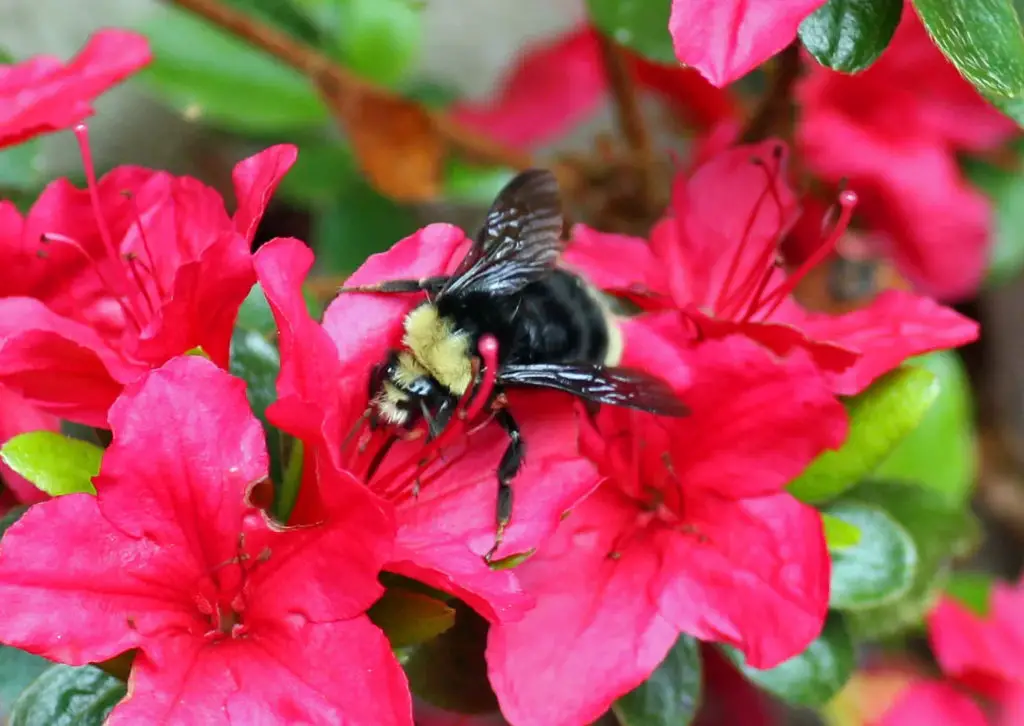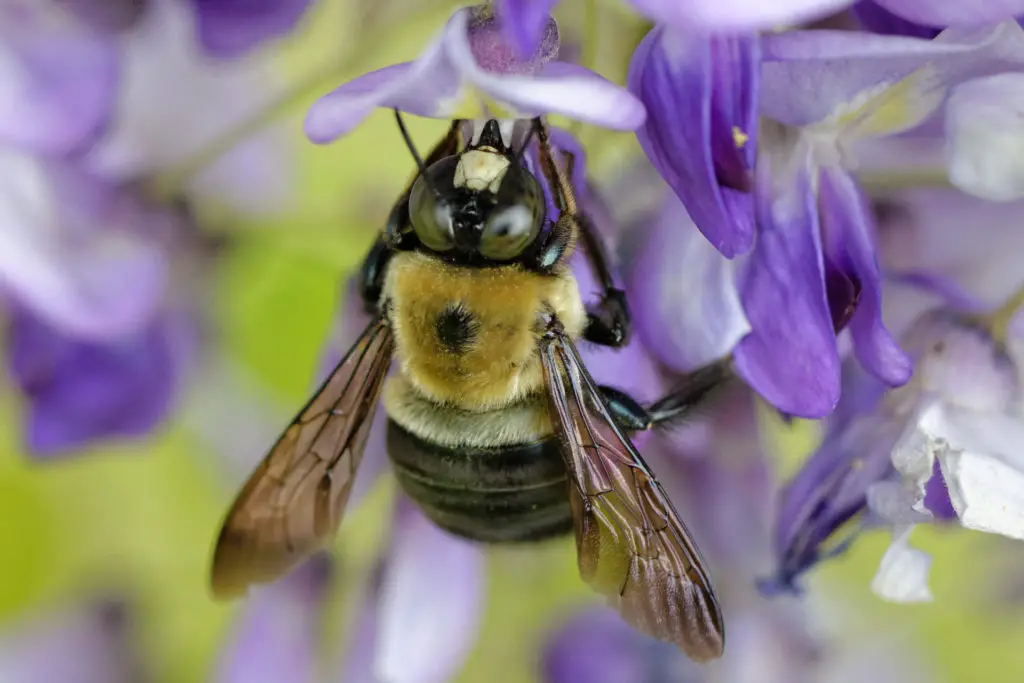Affiliate Disclaimer - As an Amazon Associate I earn from qualifying purchases.
It supports the website. So, Thank you
Bees are rarely too far from their hive whilst they are carrying out their day-to-day activities of collecting nectar and pollen from flowers. Therefore, they are perfectly able to survive for many hours without the need to nourish themselves.
In the winter, hives can survive for up to 2 years. Bees will also be able to live for several weeks without their queen, but would not survive more than 1 day without water or pollen.
How long do bees last without food?
In terms of surviving without food, it depends upon what type of Bee you are referring to, but generally speaking:
- Drone Bees – would only last a few hours without food
- Worker Bees can last many hours (as many as 24 hours) without feeding
- Queen Bees – if left away from her hive, she would only survive for a maximum of 2 days

Table of Contents
The Life Span of Bees
Worker bees have a life span of only six weeks during honey production seasons.
Honey bee colonies are an organized society of three adult castes: queens, workers and drones.
Queens produce unfertilized eggs that hatch into drones, or male honey bees. If a mature drone successfully mates with a queen, he will die soon after the mating flight.
The honey bee has a life span determined by the level of pollen and protein consumption, as well as the honey bee’s level of activity.
Worker bees are the smallest members of the colony but have the largest number of individuals.
The life span of worker honey bees ranges from five to seven weeks.
Feeding
Check whether or not the hive has food in it. If so, then there is no need to check the feed can as they haven’t been caged long.
Feeding should be done with syrup of about 1:1 and sprayed three or four times a day.
Digestion
Bees have two stomachs – a real one and a honey stomach.
The real stomach digests food while the honey stomach is a temporary storage facility for honey.
When trapped indoors, bees can digest honey from the honey stomach to increase flying time and locate possible food sources in the home.
Starvation
Starvation leads to a decrease in flying time for honey bees.
Grounded bees quickly starve to death if they do not find food.
A bee trapped indoors, without food, cannot survive more than a few hours.
Starvation can lead to dehydration, which can be fatal.
Honey bees survive the winter by creating their own heat and maintaining a food supply.
When temperatures fall and food sources disappear, honey bees form a cluster around the queen and younger bees, allowing them to feed on honey stored inside the hive.
What Is the Life Span of a Honey Bee?
The life span of a honey bee is around six weeks, however, they are totally dependent on their queen. If only the queen lives, for instance, a colony cannot survive.
Queens produce unfertilized eggs that hatch into drones, or male honey bees. The main purpose of a drone is to mate with the queen and their life span relates directly to this task.
The life span of a honey bee is determined by its level of activity and pollen consumption.
Queens, who spend their lives laying eggs inside the hive, can live for several years; workers who labor during busy seasons survive for only a few months.
How and when to feed bees
Beekeepers should feed their bees pollen in the spring and early summer, and again in the fall. There are a variety of ways to feed bees pollen, including adding it to the hive, feeding it to the bees in a liquid form, or planting flowering plants near the hive.
Place sugar syrup or dry sugar inside the hives towards evening to reduce the risk of bees robbing hives that have been fed.
Feed bees an initial feed of around 1 to 3 litres then frequently check combs to see how much syrup has been stored and use this to guide how often and how much syrup to feed your bees.
Over-feeding a colony is safer than skimping and potentially causing the death of colony
Feeding dry sugar
Bee colonies need water to dissolve sugar crystals into liquid.
Dry white table sugar is fed to bees in the autumn and spring when humidity is high.
A colony at a starvation level should be fed first before dry sugar is given, in order to give the bees immediate food.
How to Make Sugar Water for Bees
To make sugar water for bees, combine 1 part sugar with 4 parts water in a pot and heat on medium-high until the sugar has dissolved. Pour the sugar water into a jar and place it in the fridge to cool. Once it has cooled, place it in a bee feeder or in a place where the bees can access it.
How often to feed
colonies with virtually no stored honey and no incoming nectar will feed largely based on the amount of brood, size of the colony, and size of the syrup container.
It is safer to over-feed a colony than to skimp and potentially cause the death of the colony.
The properly ripened syrup should have a moisture content of around 18%. Syrup that is not ripened properly will ferment and adversely affect bees.
What Happens When a Queen Bee Dies?
When a queen bee dies, the workers will start to look for a new queen. If they can’t find a new queen, the colony will eventually die.
A colony without a queen will dwindle and eventually perish.
The queen is the only bee that can lay fertilized eggs, and her pheromones help to keep the colony orderly and productive.
When the queen dies or becomes ill, the scent of her pheromones diminishes, and the colony members become upset.
How long does a bee live without food?
A bee lives for about a day without food and bees can starve to death if they are not fed.
A bee will die when its body is unable to produce enough energy.
Bees will die if they are trapped in a wall or closed container.
It is important to help bees when they are dying so they do not suffer unnecessarily
Bees will start to show signs of starvation within 24 hours without food.
When bees are starving, they will exhibit behavior such as crawling around, flying in circles, and building nests high in the air.
Bees need to store honey as a reserve for times when they don’t have enough nectar to feed on.
Bees will fly long distances in search of new sources of pollen and honey.
Can bees starve to death?
Honey bees store honey in the hive for food: during winter when nectar-secreting flowers are scarce.
When nectar is in short supply or unavailable, bees draw on the honey stores in their hive. You need to frequently monitor the amount of stored honey during these times because when it has all gone the colony will starve.
Starvation can be prevented by moving bees to an area where plants are yielding nectar.
Bee colonies can be kept alive for long periods by feeding white sugar. When bees are close to death, they often cling to flowers and look quite lethargic. When they do die, they then drop off the flowers, and you may find a number of these in your gardens, especially near the most bee-friendly plants
How long do bees take to die naturally?
Bees die after they sting someone.
Beehives consist of a majority of worker bees. Worker bees who are born in the spring and summer live about 6 to 8 weeks, whereas worker bees born in the fall live 4 to 6 months.
After staying in the hive for the first few weeks of their lives, warm weather worker bees are tasked with going outside the hive to collect pollen and nectar to feed the rest of the hive. Outside the hive, bees are more exposed to predators and disease.
Worker bees take care of the brood, as well as job intensity takes its toll on spring and summer worker bees, causing burnout within 6 to 8 weeks. On the other hand, fall worker bees stay in the hive for winter and are tasked with merely keeping the queen warm, with no brood to care for, and no pollen or nectar to collect. In winter, worker bees throw out any drones that remain after they’ve been removed from hives during the early autumnal season
Bees will die if they are unable to return to the hive. Whether or not bees are killed depends on the kind of bee and how it is attacked – there is no one way that bees will die.
What does a dying bee look like?
Bees are dying at an alarming rate, and it’s important to be able to identify the symptoms of a dying bee. Some common symptoms of a dying bee include disorientation, loss of balance, lack of coordination, and abnormal buzzing.
A bee that is dying may be unable to find food and will likely die within a few days.
A bee that is dying may be able to fly but may not be able to sting.
A bee that is dying will look different from a healthy bee, with black shiny wings and less hair on her body.
Conclusion
Bees can die from a variety of causes, including starvation, disease, and being attacked.
It is important to be able to identify the symptoms of a dying bee in order to save as many bees as possible.
Bees play an important role in our ecosystem, and we should do what we can to help them when they are dying so they do not suffer unnecessarily.




